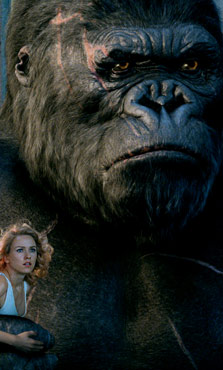 A self-indulgent film rarely announces itself as such. The feeling that a movie is in love with itself usually bubbles along below the surface. In that first, indelible viewing, there slowly develops a sense that the director has been given a little too much license, even if one can’t necessarliy point out a host of individual shots or scenes that could be slashed. After awhile you half-wish the stereotypical bean-counters at the studio had intervened, shouting the phrases “Not enough money”, “Too much!”, and “Are you nuts?” A self-indulgent film rarely announces itself as such. The feeling that a movie is in love with itself usually bubbles along below the surface. In that first, indelible viewing, there slowly develops a sense that the director has been given a little too much license, even if one can’t necessarliy point out a host of individual shots or scenes that could be slashed. After awhile you half-wish the stereotypical bean-counters at the studio had intervened, shouting the phrases “Not enough money”, “Too much!”, and “Are you nuts?”
Peter Jackson’s “King Kong” is just such a movie. The movie’s largesse is about as easy to hide as a thirty-ton ape in Times Square. After a fabulously constructed beginning, and an engaging middle, the film takes a disastrous turn when the search party on Skull Island lands in a den of spiders, crabs, and other creepy crawlies. This sequence is long, disgusting, and totally unnecessary to the plot. I am not even sure it has any redeeming value as a DVD bonus, although one should never underestimate the free time and obscenity threshold of movie geeks (many of whom are already hunting through Craigslist for “meat weasels”). The scene doesn’t belong in the movie. It’s such a shocking instance of pointless stimuli that one begins wondering, with every scene that follows—especially beginning right around the two-hour and twenty minute mark—why an editor with a nimble razor didn’t tame this lumbering beast.
A serious complaint, but I have to admit it’s about the only one I have for this otherwise well-crafted and lavish story of beauty and the Watts. The set-up works wonderfully, building maximum suspense leading to the first sighting of Kong. The principles—radiant Naomi Watts as the down-on-her-luck actress, Jack Black as the manic director, and Adrien Brody as the longsuffering writer—are engaging and likeable. The ship’s crew is ripped right out of the pages of a comic book and provide a pulpy texture to the early scenes on board the ship. I loved the stowaway reading “Heart of Darkness”; whatever else it is, “King Kong” finds its origins in everything from highbrow adventure stories (Conrad) to ripping Victoriana (Haggard, Doyle, Wells). The young Peter Jackson must have spent as much time with cheap paperback classics as he did lurking in darkened cinemas.
Of course, more than anything else “King Kong” is a remake of one central source—the original 1933 version as well as the 1976 update. Usually the world doesn’t need remakes like this, but in this case Jackson was entirely justified in remaking “King Kong” because the technology allows him to give the big ape more soul and intelligence than in any previous incarnation. The interaction between Watts and Kong (Andy Serkis, who also plays the chef) is delightful and surprisingly believable. Kong even sports a monkeyish sense of humor, a development akin to watching Steven Segal tearing it up in a Broadway musical but so much more welcome. That the ape is actually rendered as a sentient creature is a marvel to behold, and Jackson proves, as he did in “Lord of the Rings”, that new CGI technologies need not be alienating. Used correctly, they can make these kinds of stories more human.
Talk about a double-edged sword, though. Jackson runs into the same problem he did in “Rings”. The more realism and humanity he can inject into these sleek, machinelike barnburners, the longer and more ponderous they become. He has a special knack for making three-dimensional stories out of one-dimensional yarns. “King Kong” would have been more fun if he had sliced and diced his way through the material as ruthlessly as Frank Miller and Robert Rodriguez did in “Sin City”. After all, I’m not sure if anyone’s eyes would have been any drier when Kong slips to his death if one hour of the movie had been cut along with most of the expository stuffing.
Indeed, the whole, mammoth film seems designed solely to amplify this beat, the original of which, one gathers, was for Jackson what the death of Bambi’s mother was to the rest of the world: a moment of terror and pathos that became a primary wellspring of imagination. Clearly, in his version, Jackson set out to deepen the big ape’s tragedy. But most of us want less earnestness and more T. Rex stomping. Ah, the T. Rex, calling to mind “Jurassic Park”, to which Jackson pays homage. At his best, Spielberg’s taut thrillers exemplify the cardinal rule of popcorn movies: audiences want to be moved, sure, but not to the point of drawing out the hankies. I imagine Jackson’s “Jaws” remake will be three hours long and introduce a poignant back-story for the predator involving cruel fishermen, dead baby sharks, and a disgraced but redemption-seeking ex-Sea World trainer. If Jackson ever discovers the purity of the lean-and-mean adventure tale, watch out. |